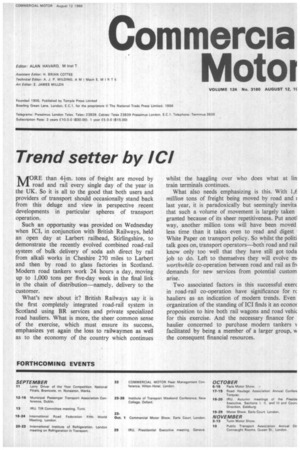Trend setter by ICI
Page 19

If you've noticed an error in this article please click here to report it so we can fix it.
WRE than 4+m. tons of freight are moved by oad and rail every single day of the year in the UK. So it is all to the good that both users and providers of transport should occasionally stand back from this deluge and view in perspective recent developments in particular spheres of transport operation.
Such an opportunity was provided on Wednesday when ICI, in conjunction with British Railways, held an open day at Larbert railhead, Stirlingshire, to demonstrate the recently evolved combined road-rail system of bulk delivery of soda ash direct by rail from alkali works in Cheshire 270 miles to Larbert and then by road to glass factories in Scotland. Modern road tankers work 24 hours a day, moving up to 1,000 tons per five-day week in the final link in the chain of distribution—namely, delivery to the customer.
What's new about it? British Railways say it is the first completely integrated road-rail system in Scotland using BR services and private specialized road hauliers. What is more, the sheer common sense of the exercise, which must ensure its success, emphasizes yet again the loss to railwaymen as well as to the economy of the country which continues whilst the haggling over who does what at lin train terminals continues.
What also needs emphasizing is this. With 1,6 million tons of freight being moved by road and last year, it is paradoxically •but seemingly inevita that such a volume of movement is largely taken granted because of its sheer repetitiveness. Put anotl way, another million tons will have been moved less time than it takes even to read and digest White Paper on transport policy. So whilst the politi talk goes on, transport operators—both road and rail know only too well that they have still got toda job to do. Left to themselves they will evolve mi worthwhile co-operation between road and rail as fn demands for new services from potential custom arise.
Two associated factors in this successful exerc in road-rail co-operation have significance for rc hauliers as an indication of modern trends. Even organization of the standing of ICI finds it an econor proposition to hire both rail wagons and road vehic for this exercise. And the necessary finance for haulier concerned to purchase modern tankers v facilitated by being a member of a larger group, w the consequent financial resources.












































































































